Veteran astronauts Neil A. Armstrong, Edwin E. “Buzz” Aldrin, Jr., and Michael Collins comprised the crew. They named the Command Module (CM) “Columbia.” Armstrong and Aldrin would descend to the Moon’s Sea of Tranquility in a Lunar Module (LM) named “Eagle.”
Throughout the 1960s, the United States engaged in a “space race” with the Soviet Union to reach the Moon. The Soviets achieved milestones like first spacecraft to impact the Moon (Luna 2); first images of the lunar far side (Luna 4); first soft landing on the Moon (Luna 9); first lunar orbiter (Luna 10); and first biological flight around the Moon (Zond 5) with unpiloted craft. Their human exploration programs racked up such successes as first human in space, first multi-person spacecraft, and first space walk. Despite these early successes, from the mid-60s on, the United States outpaced the Soviets in space as Apollo built momentum. With the upcoming launch of Apollo 11, it looked like the United States would reach the Moon first.
However, the Soviet Union had one last effort to at least partially upstage the United States in the race to reach the Moon. The Soviets built an automated craft that could land, scoop up some soil and return to Earth. This way, even if the first person to step on the Moon was an American, perhaps Soviet scientists could be the first to receive lunar material.
Luna 15 began its voyage on July 13, 1969. At the time, the Soviets did not release the true nature of Luna 15’s objectives, but there was plenty of speculation in the Western press. With Apollo 11 about to embark, a sample return mission made the most sense.
Millions of people around the world watched Apollo 11 lift off on television. At 9:32 a.m. EDT, July 16, 1969, the Saturn V thundered skyward.
This July 20, 1969 photograph of the interior view of the Apollo 11 Lunar Module shows astronaut Edwin E. “Buzz” Aldrin, Jr. during the lunar landing mission. The picture was taken by astronaut Neil A. Armstrong, commander, prior to the landing. Image Credit: NASA
Eleven minutes, fifty seconds later, Armstrong, Aldrin and Collins reached orbit. They circled the Earth one and a half times while they checked the spacecraft before the “translunar injection” (TLI) burn by the Saturn’s third stage. Mid-way through the second orbit the TLI burn sent Apollo 11 on its way to the Moon. For about six minutes, the engine accelerated the craft, propelling it free of Earth’s gravitational pull. Traveling more than 24,000 miles per hour, Armstrong, Aldrin and Collins began the three-day coast to the Moon.
The next morning, Mission Control radioed the day’s news to them, including an update on the progress of Luna 15, which had reached lunar orbit. NASA officials were concerned that the probe might cause radio interference with Apollo. Apollo 8 veteran astronaut Frank Borman, who had just returned from a good will trip to the Soviet Union, called their Academy of Sciences to request flight information. He was assured that Luna 15 would not interfere with Apollo 11.
As Apollo 11 approached the Moon, Armstrong reported “The view of the Moon that we’ve been having recently is really spectacular. It fills about three-quarters of the hatch window and, of course, we can see the entire circumference, even though part of it’s in complete shadow and part of it’s in earth-shine. It’s a view worth the price of the trip.”
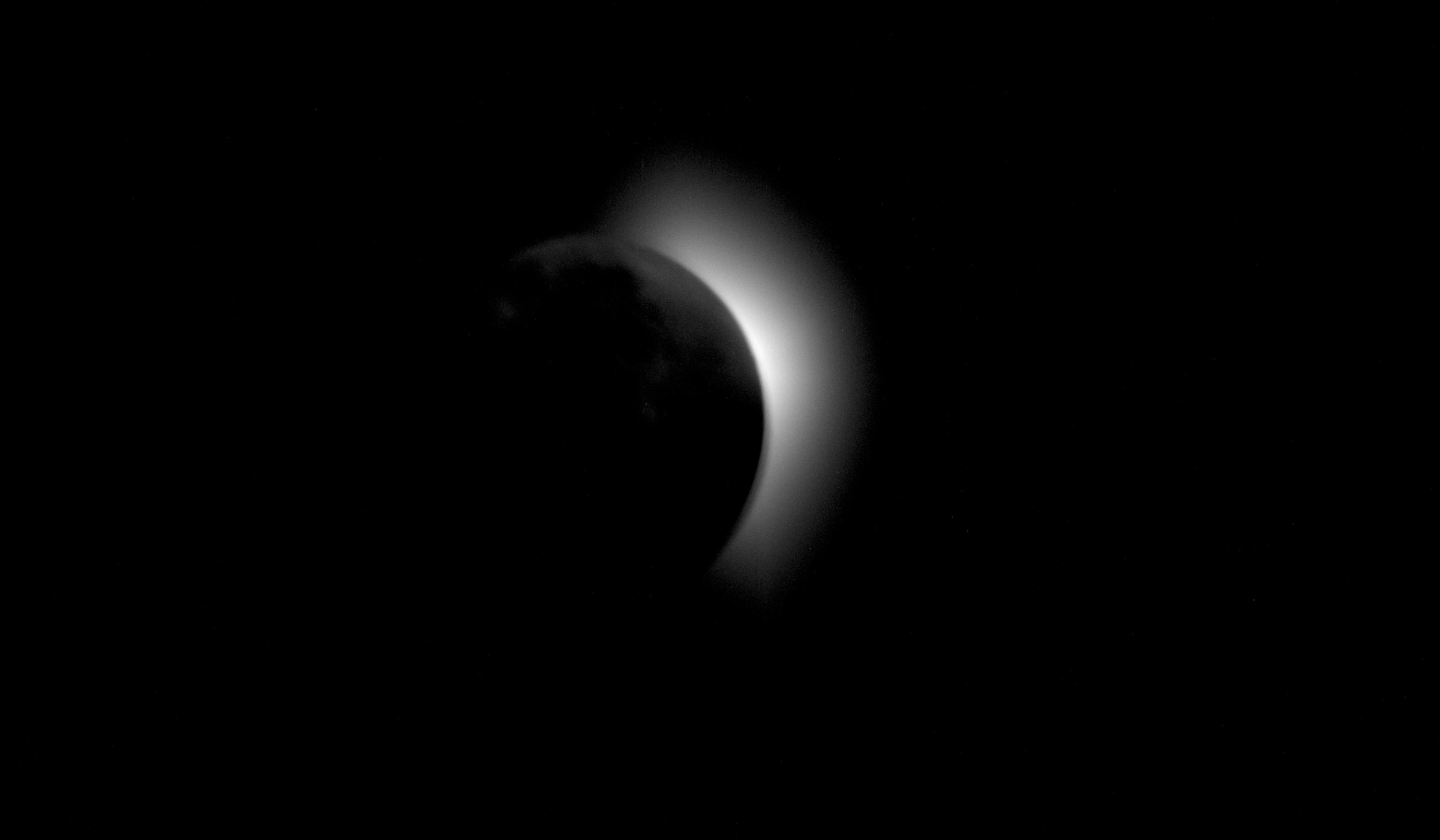
Image taken from the Command and Service Module (CSM) during the Apollo 11 mission while on a near circular lunar equatorial orbit. Image Credit: NASA
Apollo 11 reached the Moon on July 19. Just before they disappeared behind the Moon, Houston informed the astronauts: “You are go for LOI.” LOI is an acronym for “Lunar Orbit Insertion.” Over the lunar farside, Collins fired the Service Propulsion System (SPS) engine and Apollo 11 entered lunar orbit. The astronauts spent the rest of the day preparing for the landing. They circled the Moon once every two hours.
On Sunday, July 20, Aldrin turned on the power inside Eagle. About an hour later, Armstrong joined him and they conducted final checks and deployed the landing legs. The astronauts sealed the hatches and separated Eagle and Columbia at 1:46 p.m., EDT. Mission Control asked how it looked. Aldrin replied “The Eagle has wings.”
Armstrong and Aldrin fired the descent engine for the first time while they were behind the Moon. Flight Controllers in Houston had to wait until Collins emerged from behind the Moon’s shadow to find out how things went. “Everything’s going just swimmingly. Beautiful!” radioed Collins. Flying in a different orbit now, Eagle emerged from behind the Moon about two minutes later and confirmed the report.
Armstrong and Aldrin continued their descent. At 50,000 feet, the LM computer Display and Keyboard (DSKY) flashed “99.” This told Armstrong he had five seconds to decide to continue the landing or abort the attempt. He pushed the “proceed” button. The descent engine built up power and Eagle dropped out of orbit. At an altitude of 19,000 feet, the landing area came into view.
Suddenly, the DSKY read “12 02,” an executive overflow alarm. This meant the LM computer was overloaded and had to reset itself. Without a steady stream of computations, Armstrong and Aldrin would have to abort the landing. Steven Bales, the guidance officer on duty at Mission Control had seen this alarm during a simulator session and understood its cause. The computer was trying to accept data from both the landing and rendezvous radars, overloading its memory. He calmly told lead flight controller Eugene Krantz it was okay to continue as long as the alarm did not persist. The 12 02 alarm flashed five times during the descent; a similar message, 12 01, appeared once.
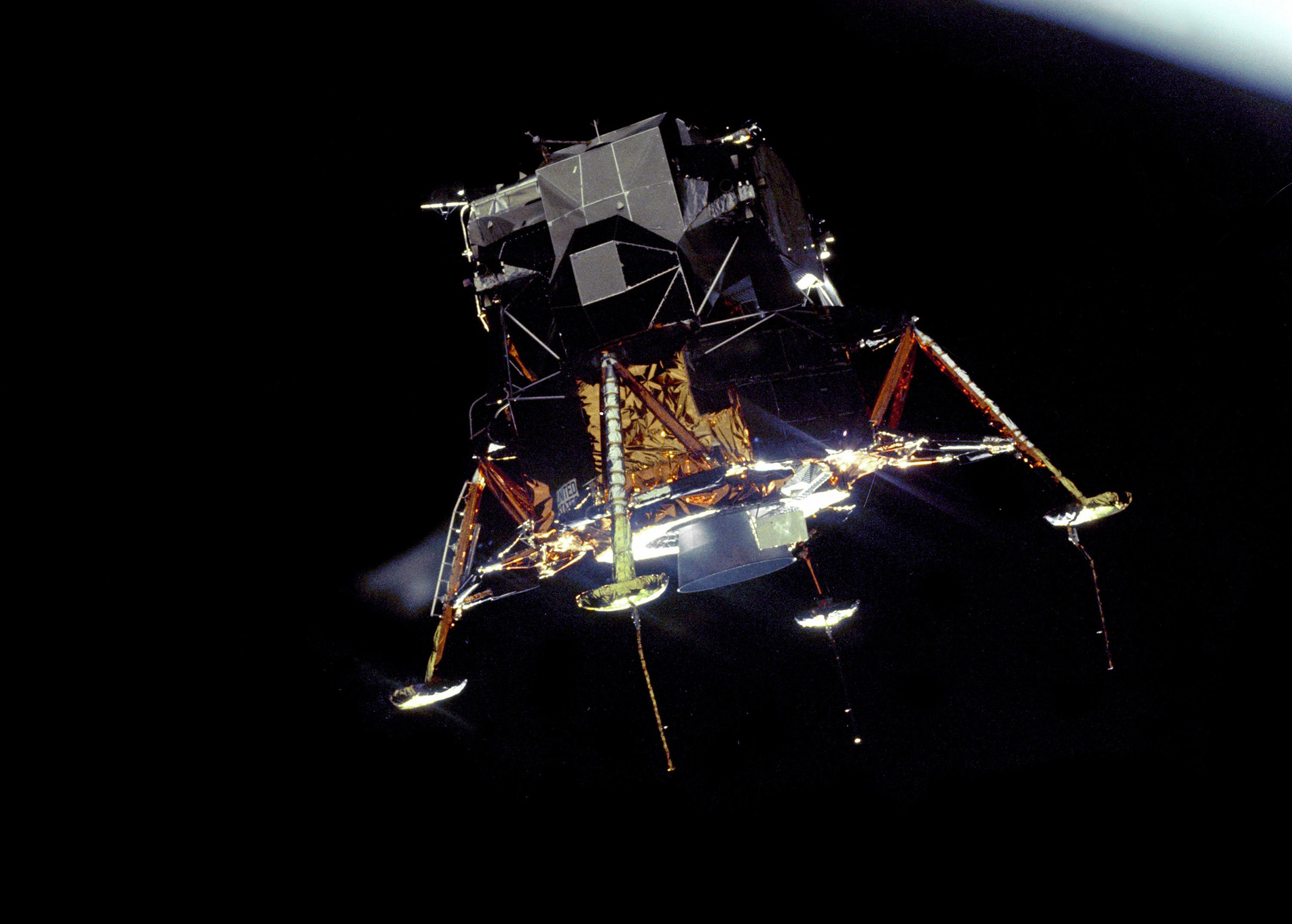
Image taken from the Command and Service Module (CSM) during the Apollo 11 mission while on a near circular lunar equatorial orbit. Image Credit: NASA
As they approached the surface, Armstrong and Aldrin were supposed to look out the windows and identify lunar surface landmarks to check where they were going to land. The computer alarms and other tasks kept them so busy they didn’t look out the windows until they were too low to identify any features. Even without any landmarks to guide him, Armstrong was sure that they were going to land about five miles beyond the target, but would still be within the Sea of Tranquility. He then saw the computer was going to set them down in a crater filled with large boulders.
Armstrong switched to the semi automatic landing mode. In this mode, the guidance and navigation system controlled only the rate of descent, in one foot per second increments subject to Armstrong’s commands. He controlled lateral movement. Skimming across the crater, Armstrong searched for a place to land. At last he found a spot and carefully guided Eagle towards it. Three of the legs had 68-inch long probes on them, to signal the astronauts to shut off the descent engine when they were about to land.
“400 feet, down at nine... Got the shadow out there... 75 feet, things looking good... Lights on... Picking up some dust... 30 feet, 2 1/2 down... Faint shadow... Four forward, drifting to the right a little...”
Mission control told him he had 30 seconds left. “Contact light.” The blue light in the center of the instrument panel came on. “Okay, engine stop. Engine arm off.”
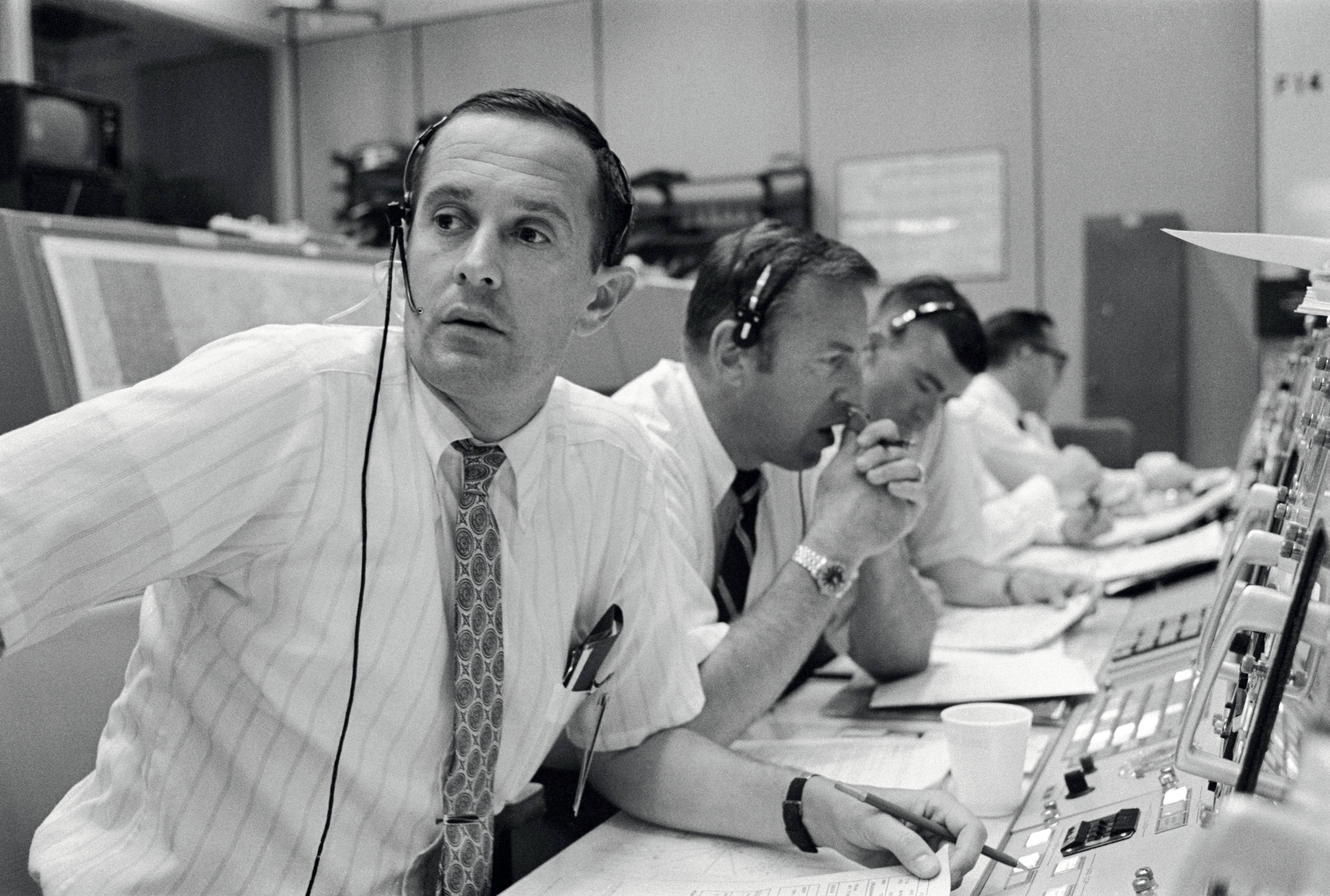
Flight controllers during lunar module descent. Image Credit: NASA
Houston replied “We copy, you’re down, Eagle.”
Then, from the Moon: “Houston, Tranquility Base here. The Eagle has landed.”
Cheers broke out in Mission Control. It was 4:18 p.m. EDT; 3:18 p.m. in Houston. The national goal, which President John F. Kennedy announced in 1961, before any American had even orbited the Earth, had been achieved. Aldrin and Armstrong simply looked at each other and shook hands.
(Based on the radio transmissions from Mission Control, many people have concluded Armstrong had less than 15 seconds’ fuel left when he touched down. According to data published in NASA SP 2000-4029, Apollo by the Numbers: A Statistical Reference, Armstrong had 674 pounds of propellant left, enough to hover for about 45 seconds.
After confirming that all was well with Eagle, Houston told the astronauts they could remain on the surface.
Peering out the window, Aldrin reported “We’ll get to the details around here, but it looks like a collection of just about every variety of shapes, angularities and granularities, every variety of rock you could find. The colors vary pretty much depending on how you’re looking. There doesn’t appear to be much of a general color at all. However, it looks as though some of the rocks and boulders, of which there are quite a few in the near area are going to have some interesting colors to them.”
Luna 15 continued to orbit the Moon, silent and mysterious. It altered its orbit twice, most recently that very day, but there still was no indication it was supposed to do any more than orbit. Soviet scientists had underestimated the ruggedness of the landing site and Luna 15’s altimeter returned erratic data. Flight controllers delayed the landing while they studied and analyzed the data.
Around 10:30 p.m., EDT, Armstrong depressurized Eagle’s cabin, opened the hatch, and wriggled out onto the “porch” at the top of the ladder. As he descended the nine rungs to the surface, he pulled a handle that opened the “Modular Equipment Stowage Assembly,” or MESA. A black and white television camera mounted inside the MESA began transmitting images of him on the ladder. “I’m at the foot of the ladder. The LM footpads are only depressed in the surface about one or two inches. The surface appears to be very, very fine-grained, as you get close to it. It’s almost like a powder.”
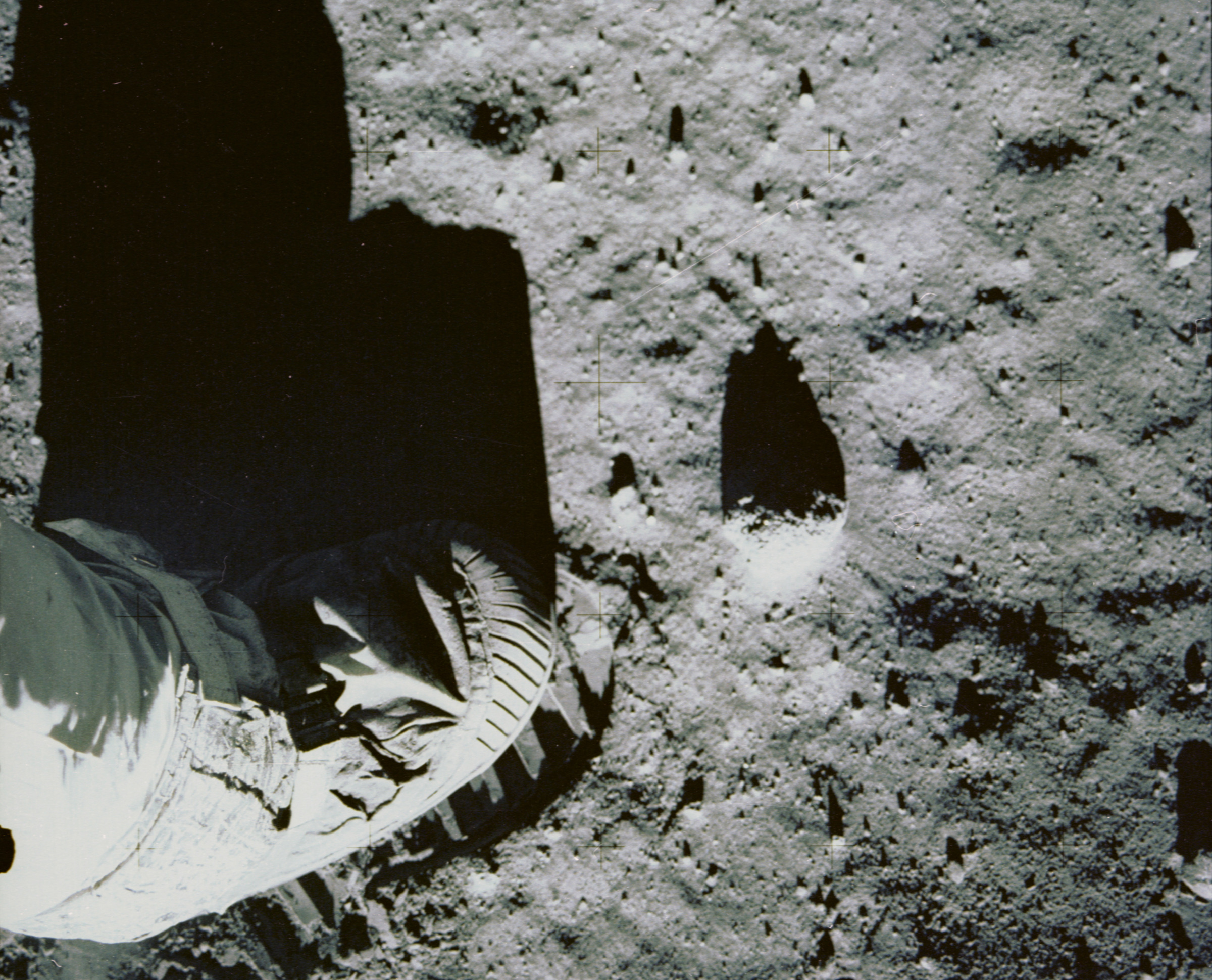
Apollo 11 astronaut Edwin Aldrin photographed his foot leaving an impression on the lunar soil as part of an experiment to study the nature of lunar dust and the effects of pressure on the surface. Image Credit: NASA
At 10:56 p.m., EDT, he put his left foot on the Moon:
"That's one small step for man, one giant leap for mankind."
The first thing Armstrong did on the surface was to collect some soil in a plastic bag and place it in one of the pockets on his space suit. Called the “contingency sample,” this assured scientists on Earth of at least a small amount of lunar material if the moonwalk had to end early. Aldrin soon joined him on the surface.
Together, they unveiled a stainless steel plaque on Eagle’s front leg. “Here men from the planet Earth first set foot upon the Moon, July 1969, A. D. We came in peace for all mankind.” It bore the signatures of all three astronauts and President Richard M. Nixon.
Armstrong moved the television camera from the MESA to a tripod a short distance from Eagle. Around the world, television audiences watched ghostly images of the pair walking and hopping on the Moon.
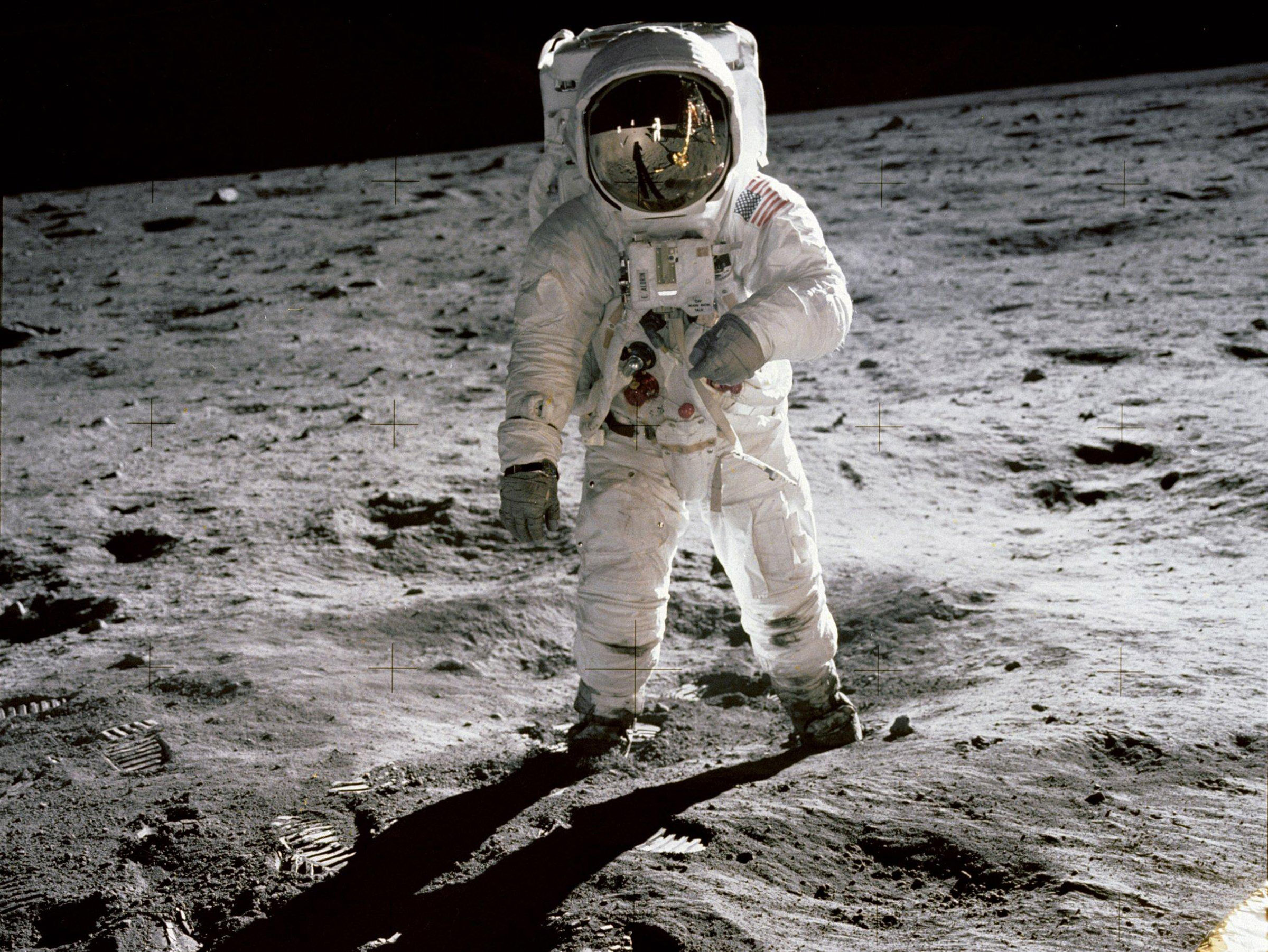
Apollo 11 astronaut Neil Armstrong photographs fellow astronaut Buzz Aldrin walking on the moon in July 1969. Image Credit: NASA
The first experiment to be deployed resembled a window shade made from aluminum foil. The Sun emits a constant stream of particles, called the solar wind. They unrolled the 1-foot by 4.6-foot foil sheet and exposed it to the Sun. This device trapped solar wind particles for later study.
Armstrong and Aldrin used tongs, shovels, scoops and other specially designed tools to gather samples. They collected “documented” samples that included photographs in situ to assist in their later analysis. The pair also gathered bulk samples and interesting looking rocks. All the lunar samples were placed in two suitcase-like aluminum boxes, the “Apollo Lunar Sample Return Containers” (ALSRCs). Aldrin used a special camera to take close-up stereoscopic images of the Moon’s surface.
About midway through their moonwalk, Armstrong and Aldrin unfurled a 3-by-5-foot nylon American flag, its top edge braced by a metal bar to keep it extended on the airless Moon. After this task was finished, Mission Control told them “The President of the United States is in his office now and would like to say a few words to you.”
President Nixon spoke by telephone. “Neil and Buzz, I am talking to you from the Oval Room at the White House. And this certainly has to be the most historic telephone call ever made... For every American this has to be the proudest day of our lives. And for people all over the world I am sure they, too, join with Americans in recognizing what a feat this is. Because of what you have done, the heavens have become part of man’s world. As you talk to us from the Sea of Tranquility, it inspires us to redouble our efforts to bring peace and tranquility to Earth. For one priceless moment, in the whole history of man, all the people on this Earth are truly one.”
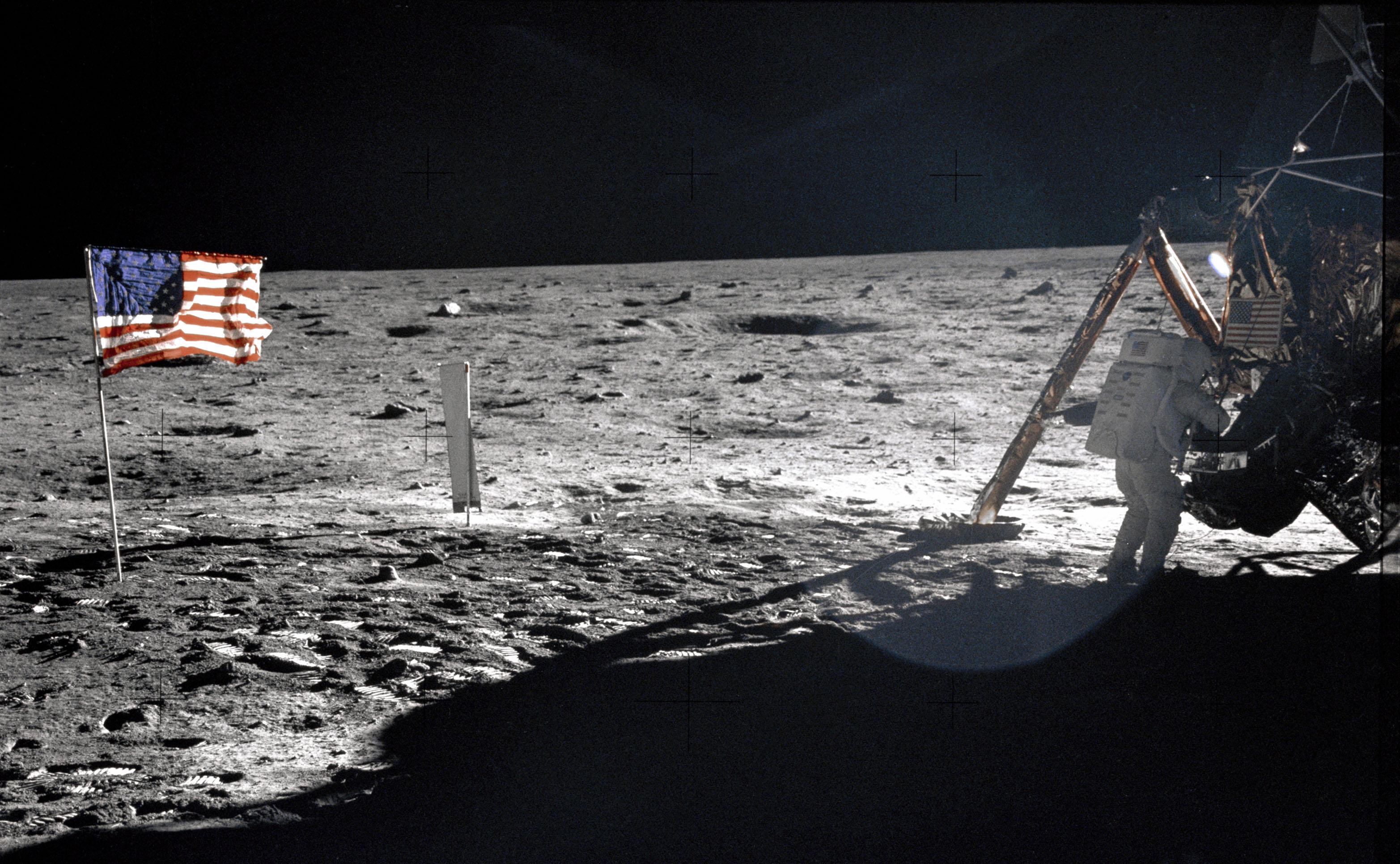
Neil Armstrong works at the LM. The 3 x 5 nylon American flag is also visible. Image Credit: NASA
Armstrong and Aldrin set up two scientific instruments to be left behind. Called the Early Apollo Surface Experiments Package (EASEP), they were a seismic detector and a laser reflector. Using the reflector, scientists on Earth could measure the distance to the Moon to within 3 inches. It could also be used to measure continental drift.
As mankind’s first moonwalk came to an end, they retrieved the Solar Wind Composition experiment and placed it in a Teflon bag. The bag went into one of the ALSRCs for return to Earth.
Aldrin climbed back up the LM ladder. Armstrong then used a rope and pulley arrangement to hoist the ALSRCs up to him for stowage in the cabin. The two containers held 78 pounds of lunar material. With the rock boxes on board, Armstrong joined Aldrin inside Eagle and closed the hatch at 1:11 a.m. EDT. They opened the hatch once more to discard the life support backpacks and lunar boots.
Finally, around 4:30 a.m., they were told to go to sleep. The Lunar Module cabin did not have seats -- the astronauts piloted the craft standing up. And, there was not enough room for both to stretch out on the floor. To sleep, the astronauts had a pair of crisscrossing hammocks that stretched diagonally across the cabin. Armstrong managed to use his; Aldrin simply curled up on the floor.
Mission Operations Control Room (MOCR) activities during the return trip of Apollo 11 on July 22, 1969. Image Credit: NASA
As he got down on the floor, Aldrin saw the switch from the Ascent Engine arming circuit breaker. Apparently one of the astronauts’ backpack life support units hit the switch and broke it. Normal procedures called for closing the breaker about two hours before lifting off from the Moon. Engineers on Earth devised a way to reroute the electrical circuit that bypassed the broken circuit breaker, but Aldrin came up with a fix of his own. He jammed the end of a felt tip marker into the breaker socket on the panel and successfully armed the engine.
By the time Armstrong and Aldrin began their final preparations to rejoin Collins, the Luna 15 mission was over. A few hours before their scheduled lift off, Luna 15 began a descent to the Sea of Crises. It could still make it back to Earth on the same day as Apollo 11, if it scooped up a sample and returned right away. However, Luna 15 apparently crashed into the side of a mountain and was destroyed along with Soviet hopes of stealing some of Apollo's glory.
Eagle’s Ascent Stage lifted off at 1:54 p.m. EDT. Just before ignition, Capsule Communicator Ronald Evans told the crew “...you’re cleared for takeoff.”
The response was: “Roger, understand we’re number one on the runway.” The ascent engine was one absolutely critical component that had to work. Without a successful firing, Armstrong and Aldrin would be stranded on the Moon with no hope of rescue. Every component of the engine, with the exceptions of the combustion chamber and nozzle bell, was duplicated in separate redundant systems. The engine performed flawlessly. A few hours later, Eagle and Columbia docked, and all three astronauts were reunited. The lunar samples were transferred to Columbia then the Ascent Stage was discarded.
Very early the next day, Armstrong, Aldrin and Collins began the long voyage home. The 3-day trip back to Earth went smoothly. Columbia splashed down about 950 miles southwest of Honolulu on July 24. President Nixon was onboard the recovery ship U. S. S. Hornet.
One of the fears that existed about the return of the first expedition to the surface of the Moon was that the astronauts might bring back alien germs. Therefore the astronauts and samples would be held in a three-week quarantine following splashdown.
Mission Operations Control Room (MOCR) activities during the return trip of Apollo 11 on July 22, 1969. Image Credit: NASA
After the recovery team secured a floatation collar around Columbia, one of the frogmen opened the hatch and handed the astronauts “Biological Isolation Garments” (BIGs). Closing the hatch while the astronauts donned the BIGs, the pararescueman scrubbed the side of the spacecraft with a bleach disinfectant. Wearing their gray isolation garb, the astronauts opened the hatch and climbed into a rubber raft. Again, the area around Columbia’s hatch was scrubbed with disinfectant, as were the astronauts. Upon their arrival aboard the Hornet, they quickly walked into a converted Airstream camper, the Mobile Quarantine Facility, or MQF.
Ensconced in the MQF, they traded the BIGs for more comfortable coveralls. A jubilant President Nixon addressed them through the window and invited them to a special awards ceremony at the White House as soon as their three-week quarantine was over. The Hornet headed for port, where the MQF was transferred to a C-141 cargo aircraft and transported to Houston and the Lunar Receiving Laboratory (LRL). The LRL had living facilities for the astronauts and laboratories for studying the lunar samples.
The astronauts completed their quarantine; there were no germs on the Moon. The elaborate quarantine procedures were relaxed on subsequent missions and eliminated altogether beginning with Apollo 15.
Scientists eagerly awaited the chance to study the samples brought back by Apollo 11. Initially, NASA provided samples to 36 scientists and research groups from 20 institutions around the world. In addition, small quantities of lunar material and flags that had flown aboard Apollo 11 were presented to 135 nations, US possessions and states.
Read the complete “Season of Apollo” series.